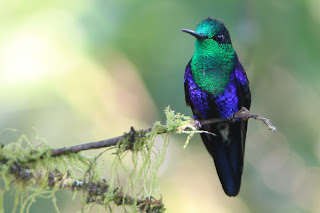Watching hummingbirds is a breathtaking experience. There are enough clues that they are birds, but so much else of what they do is so completely wacko. They come in psychedelic packaging. They fly backwards, and they can hover in one place. Their acceleration and deceleration are barely within the bounds of physical laws. They flap their wings so fast that all you can see of them are two blurs. And yes, you can hear the humming. All those adaptations are designed to capture the nectar market, but they are so energy intensive that the birds have to go into a state of torpor when they rest. In the remaining time they have to ingest twice their body weight's worth of food.
There can't be too many better place to see hummingbirds than the cloud forests of Mindo. Our lodge had a balcony at canopy level and our host had hung a few feeders out. The birds that came to feed had a convenient (for me) habit of perching back on the exact same twig between sorties to the feeder, making it relatively easy to photograph them. Here are a few I managed to shoot. By the way, what a way to reach 500!
500. Green-crowned Woodnymph (Thalurania colombica fannyi)
501. White-necked Jacobin (Florisuga mellivora)
502. Green-crowned Brilliant (Heliodoxa jacula)
-->504. Brown Violet-ear (Colibri delphinae)
505. Green and White Hummingbird (Amazilia viridicauda)
506. Long-tailed Sylph (Aglaiocercus kingii)
507. White-bellied Woodstar (Chaetocercus mulsant)
508. Violet-purple Coronet (Boissonneaua jardini)
509. Rufous-tailed Hummingbird (Amazilia tzacatl)
510. Lesser Violetear (Colibri cyanotus)
511. Purple-bibbed Whitetip (Urosticte benjamini)
512. Brown Inca (Coeligena wilsoni)
513. Fawn-breasted Brilliant (Heliodoxa rubinoides)
Subscribe to:
Post Comments (Atom)














No comments:
Post a Comment